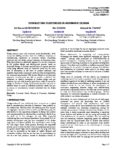
|
Connecting Customers in Axiomatic Design
Kurniawan, S. H., Zhang, M., Tseng, M. M.
3rd International Conference on Axiomatic Design, 2004
Design process starts with customer needs identification. With companies’ shifting attention from the traditional emphasis on manufacturing capabilities to customer centric, connecting customer into the design process becomes an important issue. This paper presents a systematic approach to connect customers in the product design and development process based on Axiomatic Design. It includes methodologies to capture customer needs, bring different levels of customer needs into the same level of abstraction in the form of product attributes, and prioritize those needs. Customers’ needs can then be mapped into the functional requirements (FR) domain. Based on the proposed approach, manufacturers are able to provide a platform for customers to directly participate in product design and get products that suit their personal preferences, which is termed as Design by Customer. Design by Customer provides not only an effective means to cater to individual customers’ needs but also an avenue to systematically connect customers into the design process.
|
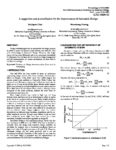
|
A suggestion and a contribution for the improvement of Axiomatic Design
Choi, D., Hwang, W.
3rd International Conference on Axiomatic Design, 2004
Design methodologies aim to systematize the design process in order to make the practice more efficient and effective. One such methodology is Axiomatic Design. However, this design theory still has some difficulties and is not completely formalized. In this paper, the new issue for the non-linear design is suggested and the representation of system architecture by flow chart is modified accordingly.
|
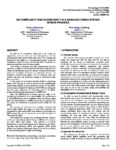
|
On Complexity and Uncertainty in a Manufacturing System Design Process
Bjelkemyr, M., Lindberg, B.
3rd International Conference on Axiomatic Design, 2004
In order to be competitive today and in the future, an organization must be aware of how their products and the correlating life cycle systems affect each other. This is particularly important in the design of a manufacturing system, where the development should be done concurrently with the product to reduce cost and time, and to increase quality. This design of products and their corresponding life-cycle systems is a complex and complicated task that is dependent of several multidisciplinary areas, for example technical, economical, social and managerial. Therefore, the correlation between the developed manufacturing system and the demands from the product and from the operations strategy is established under great uncertainty. In this paper, the connections between different engineering design tools that can be used as support in the manufacturing system design (MSD) process, within the context of two MSDmethodologies, Design for Six Sigma and KTH-IPM, are discussed. Also, the paper elaborates the relationship between the MSDprocess and the development process of a MSD-tool. Next, the MSD-process is broken down in order to be evaluated on performance and dependability. The performance of the MSD-process can be evaluated using the concept logical depth. The dependability of a MSD-process can be evaluated with the notion of uncertainty as presented by Suh [2003] and Lee [2003].
|
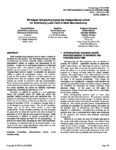
|
FR-Based Scheduling Using the Independence Axiom for Shortening Lead-Time of Mold Manufacturing
Nakao, M., Iino, K., Kobayashi, Tokusei, Tanimoto, Yamada
3rd International Conference on Axiomatic Design, 2004
Mold manufacturing operators have to make a number of decisions for each product. For shortening lead-time of mold manufacturing, we applied axiomatic design, principally the Independence Axiom, to analysis and management of the decisions. At first, we set each human decision as a functional requirement (FR). Our proposed method, a rule of “one decision per one process” or a rule of “no feedback” in a “decision-based process design”, re-scheduled the processes (=DPs) to satisfy the Independence Axiom. For example, among the 583 decisions made for one-mold production, we removed those that the computer could settle, and further reduced the number of selections with the standardization. These improvements dropped the number of human decisions (=FRs) down to the minimum set of 77 independent ones. The less human decisions can reduce the thinking/ negotiating/ waiting time, shortening the lead-time by 14 %.
|

|
Axiomatic Design of a Wing Driving Mechanism for Micro Air Vehicle with Flapping Motion
Park, Ji Hyung, Lee, K. R., Kim, K. H.
3rd International Conference on Axiomatic Design, 2004
Recently Micro Air Vehicles (MAVs) imitating the mechanism of birds or insects have been developed. As hummingbirds’ characteristics are regarded as an appropriate candidate for MAV model, the studies of hummingbirds’ aerodynamics and mechanics in relation to MAV are conducted. In this paper, an axiomatic design approach to develop a wing driving mechanism for MAV mimicking hummingbirds is proposed. Functional requirements (FRs) for the mechanism are defined through the analysis of the hummingbirds’ wing motions involving hovering, forward, and backward flight. Five FRs are introduced at the highest level. Constraints (Cs) in size and weight are taken from the limitation employed in the Defense Advanced Research Projects Agency’s MAV program. Design parameters (DPs) are conceived in physical domain to satisfy these specified FRs and Cs. Through the process of mapping and zigzagging to decompose to the next level, totally fifteen FRs and the same number of DPs are defined. The wing driving mechanism design is proved to be decoupled by design equation. Also we can reduce the complexity of the mechanism by physical integration.
|
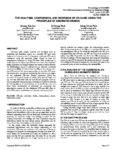
|
The Analysis, Comparison, and Redesign of CD-case Using the Principles of Axiomatic Design
Lee, K. W., Ji-Hyung Park, Jahng-Hyon Park
3rd International Conference on Axiomatic Design, 2004
CD-cases with various capacity and functions such as portability and individual access to a specific CD have been designed and manufactured. In this paper, a cake-type CD-case is redesigned using the axiomatic design theory to have the advantageous functions of other CD-cases. First, a cake-type, a wallet-type, and a cabinet-type CD-case are analyzed by axiomatic design approach and design matrices are made to check whether the independence axiom is satisfied or not. Second, functional requirements (FRs) are derived from the FRs of the existing caketype CD-case and the advantageous FRs of the other CD-cases. Constraints (Cs) are defined considering the volume and weight of the improved CD-case. Design parameters (DPs) are conceived in physical domain to satisfy these specified FRs and Cs, and two alternative DPs for one FR are proposed. One of these alternatives having the least information content is selected by defining FRs as the minimization of the production cost and time. Also marketability is estimated by comparing the information content of the redesigned CD-case with that of other CD-cases in consideration of capacity, volume, and price.
|
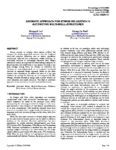
|
Axiomatic Approach for Stress Relaxation in Automotive Multi-shell-structures
Lee, Hyungyil, Gyung-Jin Park
3rd International Conference on Axiomatic Design, 2004
Recent attempt to enhance safety against collision has reshaped the simple single-shell structure into the integrated multi-shell structure. Moreover, due to various regulations continuously tightened for environment, weight reduction of automobile becomes an increasingly important issue. Weight reduction is mainly accomplished by better redesign, adoption of lighter materials, and small-sizing of auto (parts). Focusing on the local redesign among three, we attempt to determine the thickness of each subpart-shell of an integrated multi-shell structure by axiomatic design approach. Based on the finite element stress calculations, we relieve the stress of a box type subframe by varying the thickness of each subpart-shell. The redesign method successfully brings both a preset amount of stress relaxation and weight reduction. This kind of axiomatic approach can be extended to the other multi-shell structures.
|

|
New Formulations of Design Optimization New Formulations of Design Optimization for Six for Six-sigma, Reliability and Robustness sigma, Reliability and Robustness
Kwak, B. M.
3rd International Conference on Axiomatic Design, 2004
Byung Man KWAK
Samsung Chair Professor, Dept of Mechanical Engineering
Director, Center for Concurrent Engineering Design (CCED)
Korea Advanced Institute of Science and Technology
373-1 Guseong-dong, Yuseong-gu
Daejeon, 305-701 Korea
http://khp.kaist.ac.kr
|
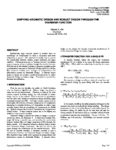
|
Unifying Axiomatic Design and Robust Design Through the Transfer Function
Oh, H. L.
3rd International Conference on Axiomatic Design, 2004
Traditionally, large complex system is evolved from an assemblage of components to form a subsystem and from subsystems to system. The approach invariably fails to capture the connectivity between various output measures and input variables. This paper proposes to “connect the dots” by relating output measures to input variables through the transfer function. With the aid of the transfer function, it becomes possible to give a mathematical treatment of Axiomatic Design and robust design. The treatment clarifies such concepts as independence and information content in Axiomatic Design. It extends robust design to design for multiple functional requirements. It unifies Axiomatic Design and robust design. Examples are provided to illustrate the unification.
|
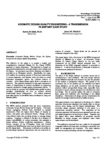
|
Axiomatic Design Quality Engineering – a Transmission Planetary Case Study
El-Haik, B., Wasiloff, J. M.
3rd International Conference on Axiomatic Design, 2004
The objective of this paper is to present a simple and comprehensive integrated Design for Six Sigma (DFSS) approach to design robustness. The approach is hinged on conceptual components for axiomatic design, robust design and Six Sigma. An automatic transmission planetary case study is provided as an illustration vehicle. Specifically, this paper will explore the cascading process of functional requirements to design parameters and features while providing an initial robustness assessment against the common sources of variation. A Six Sigma design quality level is pursued as an objective. The approach presented in this paper represents a stream of development to achieve excellence by improving customer satisfaction through quality enhancement efforts. It can be viewed as a process with detailed steps needed to cast a complete understanding of how to achieve desired breakthrough design improvement. The method presented here relies heavily on the DFSS theory developed by Yang and El-Haik (2003).
|
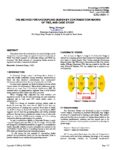
|
The Method for Uncoupling Design by Contradiction Matrix of TRIZ, and Case Study
Kang, Young Ju
3rd International Conference on Axiomatic Design, 2004
This paper shows the method how the coupled design can be changed to uncoupled design by logical and systematic process of TRIZ. The brief concepts of Axiomatic Design and TRIZ are reviewed. The detail process of uncoupling design process is explained and also a case study is showed.
|
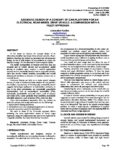
|
Axiomatic Design of a Concept of Car-platform for an Electrical Rear-wheel Drive Vehicle: A Comparison with a Fuzzy Approach
Naddeo, A.
3rd International Conference on Axiomatic Design, 2004
In this paper we analyze the concept design of an
alternative propelled rear-wheel drive vehicle’s chassis, of carplatform,
focusing the interest on pavement and sub-pavement
design, so that it will contain 18 accumulators to supply the
electrical energy ( for the electrical or hybrid engine) needed.
|
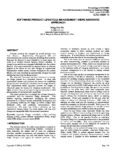
|
Software Product Lifecycle Management Using Axiomatic Approach
Do, S. H.
3rd International Conference on Axiomatic Design, 2004
Software products are managed by several activities over their lifecycle. Requirements, Development, QA and Documentation are common categories describing these activities. Although the lifecycle is often referred to in linear terms, the reality is an iterative dynamic between lifecycle activities. A change in one activity can propagate indefinitely over the product lifecycle. One major reason for the frequent failure of software projects is the failure to deal with changes to requirements. Requirements seldom remain constant throughout the product lifecycle and must therefore be systematically managed to avoid introducing chaos into the design process. The axiomatic framework has been introduced to manage the design process in a systematic manner. It starts with requirements capture and continues the process by establishing linkages between domains (i.e. activities) over the design hierarchy. This requirements driven approach provides the insight to objectively gauge the impacts of changing requirements. The highly dynamic nature of software development provides an ideal demonstration of the framework’s capabilities.
|
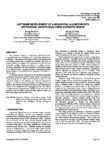
|
Software Development of a Sequential Algorithm with Orthogonal Arrays (SOA) Using Axiomatic Design
Yi, J. W., Gyung-Jin Park
3rd International Conference on Axiomatic Design, 2004
The automatic design of engineering systems has been accomplished by the development of engineering optimization techniques. The methods find design solutions that minimize the cost function while given constraints are satisfied. The types of design variables are classified into continuous and discrete ones. Generally, available designs are discrete in design practice. However, optimization has been developed to determine designs in a continuous space. In recent research, a sequential algorithm using orthogonal arrays (SOA) has been proposed for design in a discrete space.
|
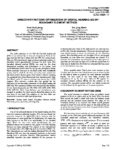
|
Directivity Pattern Optimization of Digital Hearing Aid by Boundary Element Method
Jarng, S. S., Kwon, Y. J.
3rd International Conference on Axiomatic Design, 2004
The noise reduction of the ITE (In-The-Ear) hearing aid (HA) can be achieved by an array of microphones. Each of the right and the left ears is fixed with two ITE HA microphones. This two HA microphones’ array produces particular patterns of directivity which geometrically increases the S/N ratio. The boundary element method (BEM) was used for the three dimensional modeling and optimization of the human head model directivity pattern with the two by two microphone arrays. Three particular structures of the head model were considered; sphere, head I, head II. All three structures were meshed for boundary surface element grids. Head model I element meshing was generated from three dimensional laser scanned points’ data. And Head model II element meshing was formed by a CAD program. This numerical analysis was then applied for the calculation of the time delay parameters of the digital hearing aid DSP chip. The separation between two microphones was fixed to 10 mm. Input frequencies are 500, 1000, 1500, 2000, 2500, 3000, 3500, 4000 Hz. Time delays between two microphones were changed to produce the most narrow directivity pattern in the fore front of the head. The variation of the time delay was examined in accordance with input frequencies.
|
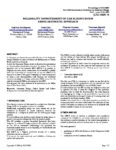
|
Reliability Improvement of Car Sliding Door Using Axiomatic Approach
Arcidiacono, G., Citti, P., Fontana, V., Martelli, T.
3rd International Conference on Axiomatic Design, 2004
In this paper, we discuss the potential utilization of the Axiomatic Design methods in order to enhance the development of Failure Modes and Effects Analysis. At first the Axiomatic Design allows to describe the optimisation of decomposition physical-functional of the project. Due to this operation and to the esteemed RPN (RPNe) it is possible to enlighten the most critical components, so to establish a priority order for intervening on components. To use the FMEA it is important to have a very good knowledge of these components to make a new decomposition until reaching the functional requirements (FRs) and design parameters (DPs) leaves. At this state we must apply FMEA, calculating the true RPN. This approach has been validated by its application to the sliding door of Fiat Auto vehicle.
|
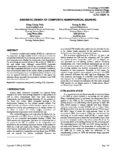
|
Axiomatic Design of Composite Hemispherical Bearing
Park, D. C., Kim, S. S., Kim, J. W., Lee, D. G.
3rd International Conference on Axiomatic Design, 2004
Composite hemispherical bearings (CHB) are employed for the suspension of high mobility tracked vehicles to transfer the compressive load from the connecting rod to the piston in an inarm suspension unit. During the compressive load transmission, the connecting rod journal rotates on the surface of CHB like a ball and socket joint. Although carbon-PEEK composite materials have been mainly used for the conventional CHB due to their high compressive strength as well as low friction coefficient, they are frequently failed by the surface cracks generated during the manufacturing process of hemispherical shape at lower cycles than its required endurance life. Therefore, in this paper, the axiomatic design approach was employed to develop a new CHB with enhanced endurance life.
|
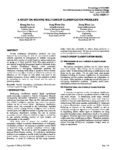
|
A Study on Solving Multi-group Classification Problems
Lee, K. S., Cha, S. W., Lee, D. W.
3rd International Conference on Axiomatic Design, 2004
Solving multi-group classification problems has been improved by overcoming the limit of conventional statistical methods supported by development of artificial intelligence methods. But a number of studies based on various methods are still going on in many academic fields. This paper presented a new method by applying Set approach based on Axiomatic design to Pairwise Comparison Method which accelerates discriminations at multi-group classification problems. For verification, evaluating bond rating is applied to Neuro-Genetic model, and a new object function is retrieved to overcome the difference of the number of data which may occur at the Pairwise Comparison. At last, validity of this method is verified by comparing the result of new method with the result of preceding studies.
|
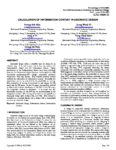
|
Calculation of Information Content in Axiomatic Design
Shin, G. S., Yi, J. W., Yi, S. I., Kwon, Y. D., Park, G. J
3rd International Conference on Axiomatic Design, 2004
Axiomatic design offers a scientific base for design in an efficient way. It is well known that it has two axioms: the Independence Axiom and the Information Axiom. Many applications of the Independence Axiom have been published, however, the Information Axiom has been mainly applied to 1FR (functional requirement)-1DP (design parameter) problems except for a few case studies. This research presents various methods for calculation of information content. Generally, the information content is evaluated by the probability of success. The probability of success is calculated in two ranges: the FR range and the DP range. In the FR range, the graphical method is utilized with uniform distribution of the DP. In the DP range, the integration method is employed. It is noted that any distribution function of the DP can be accommodated in the integration method. The developed method can be applied to a decoupled design with multiple FRs and DPs. The method is extended to a coupled design and a design with a hierarchical structure of axiomatic design.
|
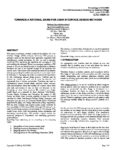
|
Towards a Rational Basis for User Interface Design Methods
Jamshidnezhad, B.
3rd International Conference on Axiomatic Design, 2004
This paper contributes towards a rational foundation for User Interface Design (UID) methods. Currently UID process is primarily based on the trial-and-error approach, supported with miscellaneous testing techniques. In fact, we lack a scientific model for UID, explaining the objectives and concepts of UID and clarifying the solutions. There is an emergent need for a UID process to be not only broad enough to be applicable in different situations but also to be accurate enough to be applicable for specific cases. The current UID methods are based on an iterative process approaching the satisfactory solution in a successive chain of activities. In this paper, we strive to constitute the foundation of this challenging, rational design process. Usability may be defined as “quality of use” and it must be planned and engineered from a human perspective. Therefore, we need to systematically respect human needs, opinions, values, feelings, skills and limitations. Since the usability of a system stems from user, task, and context of use, we base our structure on the knowledge of these three elements. We construct our design model based on a pyramid of three elements: User-System- Context Needs, Concepts, and Principles. By means of AD theory, we linked these elements together to form the overall structure in which User-System-Context Needs, Concepts, and Principles play the roles of Customer Needs (CNs), Functional Requirements (FRs), and Design Parameters (DPs), respectively. The top level contains user-system-context needs, followed by Concepts (FRs) and Principles (DPs). Through AD approach, we seek the underlying concepts and principles in UID process. This model brings about both documenting design knowledge and facilitating communication. AD provide a good format for capturing background information and describing generically good solutions.
|
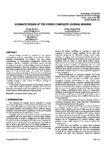
|
Axiomatic Design of the Hybrid Composite Journal Bearing
Kim, S. S., Park, D. C., Lee, D. G.
3rd International Conference on Axiomatic Design, 2004
Journal bearing materials are required to have special characteristics such as compatibility with journal interface materials, embeddability for particles and wear debris, conformability to accommodate misalignment, thermal and corrosion resistance. Although conventional journal bearing materials such as white metals or babbitt metals meet almost the required characteristics, they have possibility of seizure between the bearing material and the journal when the oil film is broken. From the manufacturing point of view, the functional requirements of journal bearing are “to reduce the manufacturing cost with easy processes,” “to be easily repaired and maintained,” and etc. These functional requirements are not easy to satisfy simultaneously with conventional manufacturing methods such as centrifugal casting of white metals and filament winding of composite materials. In this study, a hybrid composite journal bearing composed of carbon fiber reinforced phenolic composite liner and metal backing was developed to solve the problem of the conventional journal bearings with the axiomatic design approach.
|
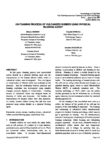
|
On Foaming Process of Vulcanized Rubber Using Physical Blowing Agent
Shimbo, M., Nomura, T., Muratani, K., Fukumura, K.
3rd International Conference on Axiomatic Design, 2004
In this paper, foaming process used supercritical carbon dioxide as a physical blowing agent and the characteristics of the foamed silicone rubber, which is vulcanized rubber, were investigated. First, the degree of vulcanization of silicone rubber was evaluated by the plasticity. And the relationship between plasticity and foaming conditions was investigated using samples changed variously degrees of vulcanization. Foaming process of vulcanized rubber was designed based on plasticity of rubber and discussed. And besides, the characteristics of foamed rubber were also measured. As results, foamed rubbers having fine cell size were produced using carbon dioxide as a physical blowing agent.
|
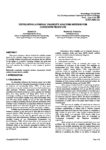
|
Developing a Formal Usability Analysis Method for Consumer Products
Lo, S., Helander, M. G.
3rd International Conference on Axiomatic Design, 2004
This paper proposes a formal method for usability analysis based on the axiomatic design theory. It characterizes the degree of coupling between user goals and user actions that are defined by the design of a product. Couplings between user goals and action reduce usability. As an analytical tool, this method can save time and resources by enabling an early analysis of product usability.
|
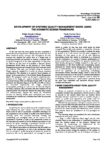
|
Development of Systemic Quality Management Model Using the Axiomatic Design Framework
Calarge, F. A., Lima, P. C.
3rd International Conference on Axiomatic Design, 2004
In the past years the word quality has been considered a synonymous of success or failure. This situation results from how firms understand quality concepts. The development of such concepts has changed the quality view as a simple way of controlling products and processes to develop a systemic vision of quality management in the whole organization. In this sense, the objective of this paper is to propose a Systemic Quality Management Model based on the precepts of Total Quality Management approach and oriented by the firm’s customer needs and attributes. This work was developed using the Axiomatic Design approach, established in function of axioms, corollaries and theorems. The objective is to improve “good practices of design” in the construction of the Systemic Quality Management Model. The proposed model was developed considering three domains in the design of a system: Customer Domain (CA), Functional Domain (FR) and Physical Domain (DP). It was also developed the hierarchy diagram of the FRs and DPs, as well as the functional requirements and design parameters decomposition, pointing out each level of the hierarchy diagram the design equations, steps and leaves that were obtained for the related elements. The model also includes the entire design matrix and module-junction diagram that shows the hierarchical structure of modules. Finally, some conclusions were drawn considering the benefits and constraints faced with the proposed development.
|
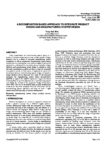
|
A Decomposition Based Approach to Integrate Product Design and Manufacturing System Design
Kim, Y. S.
3rd International Conference on Axiomatic Design, 2004
Early consideration of manufacturing system issues in a product development process prevents excessive product design iterations due to a failure to recognize manufacturing system constraints, as well as unnecessary manufacturing system design modification to accommodate new product designs. A structured approach to understand the interaction between product design decisions and manufacturing system design is essential to make this early consideration possible and thus, is a key for successful new product launch. In this paper, an approach to capture the interactions between manufacturing system design and product design decisions will be discussed. As a basis of the proposed approach, the manufacturing system design decomposition (MSDD) is applied. The MSDD represents a logical functional decomposition of general objectives of a manufacturing system and adopts the concept of the Axiomatic Design theory [Suh, 1990, 2001]. The use of the MSDD helps product development teams to see how their decisions affect the achievement of the manufacturing system objectives and thus, to make a right decision from the early stage of product development.
|
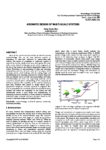
|
Axiomatic Design of Multi-scale Systems
Kim, S. G.
3rd International Conference on Axiomatic Design, 2004
Many of the current research activities are directed towards nanotechnology. The use of nano products requires an integration of nano-scale structures to macro/micro-scale systems. The degree of complexity of multi-scale systems is expected to increase rapidly as the scale order grows. The scale order can be defined in this paper as the relative magnitude of the size of the system to the smallest characteristic length of the system. Production of next generation IC chips and upcoming nanoproducts will have the scale order of 9 or above, which obviously will be a hard challenge with the existing design and manufacturing tools. Axiomatic approach for systems design has been an effective tool to provide new functionalities and better manufacturability of many new engineering products, and is expected to provide better understanding of the complexity of multi-scale systems. The causalities of the systems complexity have been reviewed with respect to design axioms and a hypothetical complexity reduction approach is proposed. The scale decomposition of a multi-scale system into small-scale order domains will reduce the complexity of the system and will subsequently ensure a good design and manufacturing by developing functional periodicity. A novel method of assembling individual carbon nanotube has been developed based on the concept of axiomatic design and complexity theory.
|
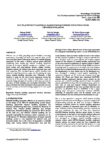
|
Multi-attribute Material Handling Equipment Selection Using Information Axiom
Kulak, O., Satoglu, S. I., Durmusoglu, M. B.
3rd International Conference on Axiomatic Design, 2004
Effective use of labor, providing system flexibility, increasing productivity, decreasing lead times and costs are some of the most important factors influencing selection of material handling equipment. In this study, a decision support system (MHAD) considering these factors for material handling equipment selection is developed. MHAD consists of a database, a rulebased system and multi-attribute decision making modules. Database includes the detailed data about equipment types and their properties. The rule-based system module provides rules which are utilized by inference engine for determining the most proper material handling equipment type. Ultimately, a final decision is made for the most proper equipment among the alternatives of the same type using the information axiom of axiomatic design principles. Evaluation of alternatives is made for the cases of both complete and incomplete information. This paper introduces the fuzzy Information axiom approach and uses it in the selection of material handling equipment in a real world problem.
|
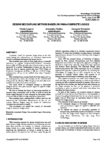
|
Design Decoupling Method Based on Para-complete Logics
Cappetti, N., Naddeo, A., Pellegrino, A.
3rd International Conference on Axiomatic Design, 2004
A primary “must” of axiomatic design theory is the first axiom, stating that independence of functional requirements should be maintained throughout the design process. Para-complete logics, such as Fuzzy logic, give us a powerful instrument to express “mathematical/functional” interaction between FRs and DPs, especially when this interaction cannot be expressed by a precise “mathematical function (i.e. the case in which we want to express several data from VOC (Voice of Customer) investigation, building an FR for a defined design performance), and so can be codified only using “Linguistic variables”.
|
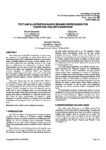
|
Text and Illustration Based Senario Expressions For Conveying Failure Knowledge
Hatamura, Y., Iino, K.
3rd International Conference on Axiomatic Design, 2004
For making use of past failure knowledge, we must convey the experience and knowledge to others. Japan Science and Technology Agency (JST, a government agency) is constructing a failure knowledge database for people to make effective use of past failure information and knowledge. Because it has a large base of information, the authors have developed effective representations for the users to reach the target information. They are the failure case illustration and text based diagonal scenario expression. A well-drawn failure case illustration generates a good image of the failure event in the readers mind, thus succeeds in passing the failure knowledge to the reader. A carefully produced diagonal scenario expression has the same effect. This paper shows how the two fundamentally different representations work. A failure case illustration alone was shown to a group of people who were asked to define a diagonal scenario expression for the case. The reverse test started from a diagonal scenario expression to reach an illustration that the group had no prior knowledge about. Our tests showed that people can produce a fairly good representation in the other form starting from either an illustration or a diagonal scenario alone. The editor of either representation can produce a good illustration or scenario definition by breaking down the failure information and making sure that each element is inserted in them.
|
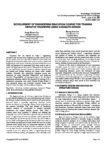
|
Development of Engineering Education Course for Training Creative Engineers Using Axiomatic Design
Cha, S. W., Lee, K. S.
3rd International Conference on Axiomatic Design, 2004
Engineers who are trained by today’s engineering education may become useful engineers for their school, but not for the society. And they also find it difficult to feel worth and happiness for themselves from their work as well as worth and happiness for their society. And they also find it difficult to feel worth and happiness for themselves from their work as well as worth and happiness for their society. This study is development of new engineering education course to cultivate engineers who can initiate new positive thinking and realize active creative activities. Especially this engineering education course was developed by using Axiomatic Design(AD) and Molecular Structure Design(MSD), and appropriateness of the developed engineering education method was examined by applying it to a mechanical engineering class called Creative Design Project 3. Also axiomatic design and molecular structure design were looked at from reversible and irreversible standpoints.
|

|
On Learning and Executing Axiomatic Design in The Engineering Industry
Bathurst,S.
3rd International Conference on Axiomatic Design, 2004
The principles of Axiomatic Design, although logical, often do not match conceptual design methods of engineering industry. Most engineering organizations try to inspect quality into the design process in the form of gate review processes with corrective change actions taken when problems observed. Iterative design cycles are common in industry. The Axiomatic design process attempts to form a rational design synthesis intended to eliminate iterations and produce the desired result in one design cycle. In order to fully take advantage of the organizational and analytical benefits of Axiomatic Design high level restructuring of an organization’s design process can be required. This restructuring effort requires a large commitment of resources and energy. This process can be extremely difficult if the engineers involved have an incomplete understanding of the methods of applying Axiomatic Design. This paper draws on experience gained teaching Axiomatic Design principles to engineers in industry. It summarizes some of the problems engineers commonly have with the Axiomatic Design learning process and it also presents suggested methods for effectively conveying an understanding of Axiomatic Design. It includes ways in which functional requirements are often misunderstood by engineers in industry as well as what parts of the axiomatic approach are most important to be communicated and understood completely. This paper discuses how important it is for a student of Axiomatic Design to apply its principles to design examples relevant to the students current design activities and offers suggestions about how engineers can adapt their existing design systems to make them compatible with coupling analysis.
|
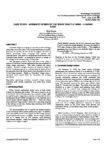
|
Case Study: Axiomatic Design of the Space Shuttle Wing – Leading Edge
Otero, R.
3rd International Conference on Axiomatic Design, 2004
Axiomatic design is emerging as a superior method of design, particularly when innovation versus incremental design is needed. However, the quantity of case studies to support education is limited, particularly those involving large systems and subcomponents. This paper is a teaching case study based on the Columbia Space Shuttle. In particular, it focuses on setting up the redesign of the shuttle’s wing – leading edge.
|
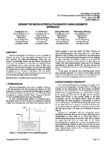
|
Design for Micro-stereolithography Using Axiomatic Approach
Lee., S. J., Lee, I. H., Cho, D. W., Hwang, W.
3rd International Conference on Axiomatic Design, 2004
Micro-stereolithography technology has made it possible to fabricate any form of three-dimensional microstructures. Until now, however, the micro-stereolithography device was not designed systematically because the key factors governing the device were not considered. In this paper, we designed microstereolithography device using axiomatic approach. This paper contains an overview and an analysis of a new proposed system for development of micro-stereolithography device, and detailed descriptions of the activities in this system. The new system offers reduced machine size by minimizing of optical components, and shows that the design matrix is decoupled.
|
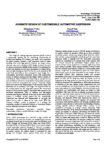
|
Axiomatic Design of Customizable Automotive Suspension
Deo, H., Suh, N. P
3rd International Conference on Axiomatic Design, 2004
The design of existing suspension systems typically involves a compromise solution for the conflicting requirements of comfort and handling. For instance, cars need a soft suspension for better comfort, whereas a stiff suspension leads to better handling. Cars need high ground clearance on rough terrain, whereas a low center of gravity (CG) height is desired for swift cornering and dynamic stability at high speeds. It is advantageous to have low damping for low force transmission to vehicle frame, whereas high damping is desired for fast decay of oscillations. To avoid these trade-offs, we have proposed a novel design for a customizable automotive suspension system with independent control of stiffness, damping and ride-height, which is capable of providing the desired performance depending on user preference, road conditions and maneuvering inputs. A suspension prototype has been built to demonstrate the concept. Axiomatic design theory was used for the development of the concept, design and fabrication of the prototype and design and implementation of the control system for the suspension system. The mechanical design of the proposed system is decoupled with respect to the functional requirements (FRs) of stiffness and ride-height; moreover ride-height is affected by the load on the vehicle (noise factor). A feedback control system for the customizable suspension was designed and implemented to uncouple the system and to make it robust to the noise factor. With this example, feedback control is proposed as a strategy for converting coupled or decoupled designs to uncoupled designs and for achieving robustness to noise factors.
|
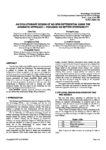
|
An Evolutionary Design of No Spin Differential Using The Axiomatic Approach — Focusing on Better Steerability
Cho, I., Jang, Y., Park, J., Combs, J. A., Pyoun, Y.
3rd International Conference on Axiomatic Design, 2004
Two No Spin Differential (NSD) models were benchmarked for a project of Dual-Use Technology. The Axiomatic approach is utilized to evaluate the designs of the models. The Independence Axiom is satisfied at the top level of design but not at the second level, which implies the design exhibits coupling and will admit design improvements. New design parameters and process parameters for better steerability which satisfy the independent axiom are developed. How to obtain the optimal value of process parameter are presented with one case. Test methodology is developed and used to evaluate the newly developed sample. The test results on the steerability are very positive regarding functional performances.
|

|
Design Improvement in a Micro-gripper System By Axiomatic Approach
Jonghyup, J., Moon, W., Park, J.
3rd International Conference on Axiomatic Design, 2004
The micro-gripper system is one of the systems that should be improved in the respect of performance for practical usage. In the previous works, the important issues are considered and presented using axiomatic design approach. In this paper, the functional requirements and design parameters are evaluated in order to improve the performance and efficiency of the system. The evaluation is a very difficult task since many variables are related to the outcomes. To provide a basis for correct design decisions, axiomatic design principles have been advanced. Since the framework of axiomatic design makes design issues easier to understand when they are analyzed, we used those as an evaluation tool.
|

|
Marine design application of design theory and methodology
Yang, Y. S.
3rd International Conference on Axiomatic Design, 2004
Young-Soon Yang
Dept. of Naval Architecture and Ocean Engineering,
Seoul National University, Seoul, Korea
|
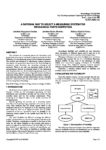
|
A Rational Way to Select a Measuring System For Mechanical Parts Inspection
Gonçalves-Coelho, A., Mourão, A. F., Navas, H. G.
3rd International Conference on Axiomatic Design, 2004
The selection of a measuring system for dimensional and geometrical tolerances of mechanical parts is crucial for the final definition of a manufacturing process and its detailed programme. The symbols and indications of adjustments, surface roughness, dimensional and geometrical tolerances in the final drawings of mechanical parts determine the measuring techniques and resources. There is not only one measuring system at all. Its appropriateness depends on particular details of the mechanical part, its production rate, its manufacturing process, human and technical means, costs, time limit, and specific contract conditions. Axiomatic Design allows comparing the information content of each measuring scheme, and this methodology can be a scientific basis for a rational selection. The present paper contains a studied real case using this methodology.
|
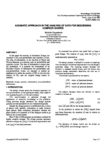
|
Axiomatic Approach in the Analysis of Data for Describing Complex Shapes
Pappalardo, M.
3rd International Conference on Axiomatic Design, 2004
In this paper the axioms, of Axiomatic Design, are extended to the non-probabilistic and repetitive events. The idea of information, in the theories of Fisher and Wiener-Shannon, is a measure only on probabilistic and repetitive events. The idea of information is larger than the probability. It is possible the formulation of an Extended Theory of Information for probabilistic and non-probabilistic events. As example is studied an application in which the number of DPs is less then the number of FRs, and the coupled design cannot be satisfied.
|

|
Integration of High-level Design Information with Axiomatic Design Formulation
Ullah, S.
3rd International Conference on Axiomatic Design, 2004
Axiomatic Design based design formulation (FRs-DPs mapping and the underlying Design Matrix) is the “meaningbase” of a design because it is human-intelligence-engaging (i.e., written in natural language), transparent (one can easily find out the rational behind the design), soft (one can easily propose modifications to improve the design), and evaluative (one can easily evaluate whether or not the design is a good or not-so-good one). To map FRs into DPs, or vise versa, however, knowledge and information is needed encoding the previous design trials, designers’ engineering judgment, overall familiarity with the design problem, and alike. AI community has built up a tradition to use inductive decision trees, qualitative models, linguistic variables, and alike to capture the above-mentioned design-relevant knowledge and information. This study uses examples of decision trees, qualitative models, and linguistic variables, and examines the logical interactions of these formatted knowledge with the mapping process of FRs from a set of given DPs, and vise versa. It is found that a heterogeneous combination of deductive, inductive, and abductive reasoning is involved in the mapping process. Further study is needed in this direction. Nevertheless, AD based design formulation should accompany other information in a system for design to increase the trustworthiness, usability, and transparency of design-relevant information to individuals directly or indirectly involved in the design.
|
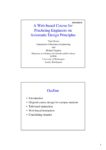
|
A Web-based Course for Practicing Engineers on Axiomatic Design Principles
Kumar, V., Campion, M.
3rd International Conference on Axiomatic Design, 2004
Vipin Kumar
Department of Mechanical Engineering
And
Michael Campion
Education at a Distance for Growth and Excellence
(EDGE)
University of Washington
Seattle, Washington
|
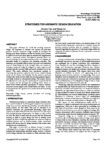
|
Strategies for Axiomatic Design Education
Tate, D., Lu, Y.
3rd International Conference on Axiomatic Design, 2004
This paper addresses the needs for teaching axiomatic design-for engineers in industry and regular and part-time graduate students. Axiomatic design consists of principles for making good design decisions, models for designs, and a process to follow, but how can these ideas be adopted and implemented within a company’s product development process? There are several challenges in successful implementation and adoption of axiomatic design by companies and practicing engineers. The challenges are especially difficult when processes and established ways of doing things are to be changed. How can courses or training in axiomatic design be designed to equip engineers and students with the necessary skills and lead to sustained use of the theory? This paper addresses four educational contexts in answering this question: engineers who receive a short training course on the theory and methods, full-time graduate students, students who work full time while also pursuing graduate degrees, and finally students in international settings. The authors discuss the objectives in each case, the constraints, the requirements for the courses, and the strategies for satisfying them. Cases are drawn from several industries, experiences of various students, and from courses taught in the United States and China. A case study is presented of a graduate-level course for students working in industry.
|
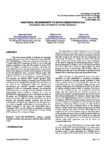
|
Functional Requirements to Shape Generation in Cad: Database and Automatic Shape Assembly
Chung, J., Lee, K. S., Suh, N. P.
3rd International Conference on Axiomatic Design, 2004
This paper presents details of databases and automatic assembled shape generation. The databases store links of FR-DPFGF- INTERFACEs and their hierarchies generated based on the V-model. Each FGF is composed of links to a set of cells and relations of interfaces of the cells. The retrieval of proper FGFs from the database is performed by matching a query FR with stored FRs linked to the corresponding FGFs by a lexical search based on the frequency of words and the sequence of the words in the FR statements using a synonym checking system. The language-matching rate is calculated as a value of FR_metric between 0 and 1. A computer algorithm automatically combines and assembles the retrieved FGFs. Genetic algorithm (GA) searches for the best matching of interface types between FGFs and generates the corresponding assembly sequences based on the codes of the chromosomes. From the highest-valued chromosome, the computer algorithm operates automatic assembly of FGFs by coordinating, orienting, and positioning FGFs with reference to the given mating conditions. Geometric interface-ability between FGFs is calculated as a value of INTERFACE_metric between 0 and 1. The higher the values of FR_metric and INTERFACE_metric, the better the design solution for the given FRs that must be satisfied in the sense of language and geometric interface matching. The top-down decomposition and bottom-up integration in the V-model reduce the number of possible combinations of interfacing FGFs. The method presented in this paper has demonstrated that a “functional CAD” can aid designers in generating conceptual design solutions from functional descriptions, in reusing existing CAD models, and in creating new designs.
|